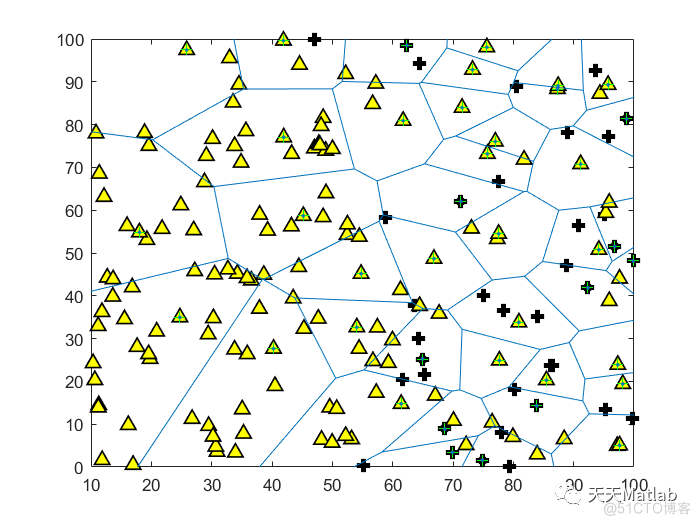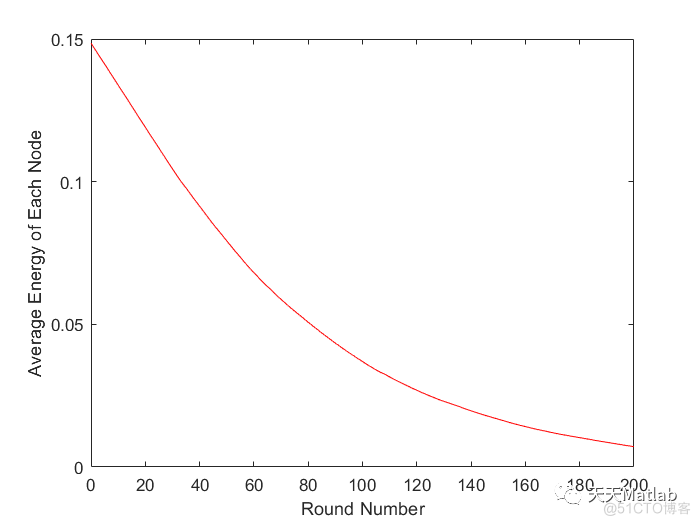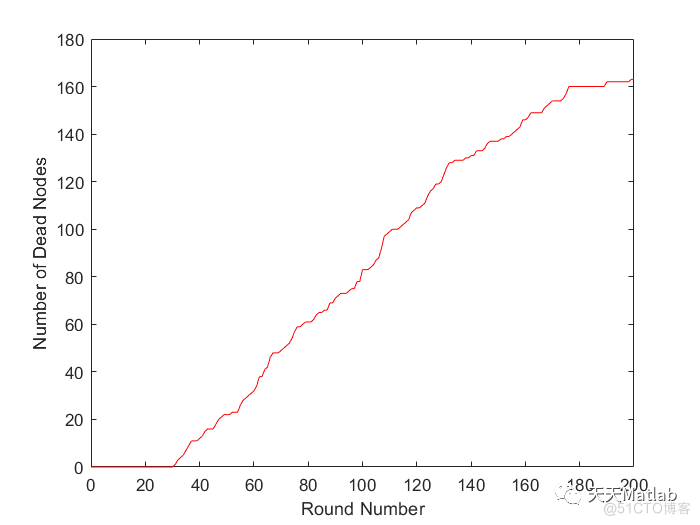1 简介 OHILEACH(Optimized heuristic ILEACH)是一种新技术,它使用基于 AI 的启发式搜索来优化网络寿命。 2 部分代码 close all; clear; clc; %------------------------------- %Number of Nodes in the field n=200;
1 简介
OHILEACH(Optimized heuristic ILEACH)是一种新技术,它使用基于 AI 的启发式搜索来优化网络寿命。
2 部分代码
close all;clear;
clc;
%-------------------------------
%Number of Nodes in the field
n=200;
%n=input('Enter the number of nodes in the space : ');
%Energy Model (all values in Joules)
%Initial Energy
Eo=0.1;
%Eo=input('Enter the initial energy of sensor nJ : ');
%Field Dimensions - x and y maximum (in meters)
% xm=input('Enter x value for area plot : ');
% ym=input('Enter y value for area plot : ');
xm=100;
ym=100;
%x and y Coordinates of the Sink
sink.x=1.5*xm;
sink.y=0.5*ym;
%Optimal Election Probability of a node
%to become cluster head
p=0.2;
%Eelec=Etx=Erx
ETX=50*0.000000001;
ERX=50*0.000000001;
%Transmit Amplifier types
Efs=10*0.000000000001;
Emp=0.0013*0.000000000001;
%Data Aggregation Energy
EDA=5*0.000000001;
%Values for Hetereogeneity
%Percentage of nodes than are advanced
m=0.5;
%\alpha
a=1;
%maximum number of rounds
%rmax=input('enter the number of iterations you want to run : ');
rmax=200;
%------------------
%Computation of do
do=sqrt(Efs/Emp);
%Creation of the random Sensor Network
figure(1);
hold off;
for i=1:1:n
S(i).xd=rand(1,1)*xm;
XR(i)=S(i).xd;
S(i).yd=rand(1,1)*ym;
YR(i)=S(i).yd;
S(i).G=0;
%initially there are no cluster heads only nodes
S(i).type='N';
temp_rnd0=i;
%Random Election of Normal Nodes
if (temp_rnd0>=m*n+1)
S(i).E=Eo;
S(i).ENERGY=0;
plot(S(i).xd,S(i).yd,'o-r');
hold on;
end
%Random Election of Advanced Nodes
if (temp_rnd0<m*n+1)
S(i).E=Eo*(1+a);
S(i).ENERGY=1;
plot(S(i).xd,S(i).yd,'+');
hold on;
end
end
S(n+1).xd=sink.x;
S(n+1).yd=sink.y;
plot(S(n+1).xd,S(n+1).yd,'o', 'MarkerSize', 12, 'MarkerFaceColor', 'r');
figure(1);
% figure(1)
% plot(o1,o2,'^','LineWidth',1, 'MarkerEdgeColor','k', 'MarkerFaceColor','y', 'MarkerSize',12);
% hold on
%First Iteration
%counter for CHs
countCHs=0;
%counter for CHs per round
rcountCHs=0;
cluster=1;
countCHs;
rcountCHs=rcountCHs+countCHs;
flag_first_dead=0;
for r=0:1:rmax
r;
%Operation for epoch
if(mod(r, round(1/p) )==0)
for i=1:1:n
S(i).G=0;
S(i).cl=0;
end
end
hold off;
%Number of dead nodes
dead=0;
%Number of dead Advanced Nodes
dead_a=0;
%Number of dead Normal Nodes
dead_n=0;
%counter for bit transmitted to Bases Station and to Cluster Heads
packets_TO_BS=0;
packets_TO_CH=0;
%counter for bit transmitted to Bases Station and to Cluster Heads
%per round
PACKETS_TO_CH(r+1)=0;
PACKETS_TO_BS(r+1)=0;
figure(1);
for i=1:1:n
%checking if there is a dead node
if (S(i).E<=0)
plot(S(i).xd,S(i).yd,'^','LineWidth',1, 'MarkerEdgeColor','k', 'MarkerFaceColor','y', 'MarkerSize',8);
dead=dead+1;
if(S(i).ENERGY==1)
dead_a=dead_a+1;
end
if(S(i).ENERGY==0)
dead_n=dead_n+1;
end
hold on;
end
if S(i).E>0
S(i).type='N';
if (S(i).ENERGY==0)
plot(S(i).xd,S(i).yd,'o','LineWidth',1, 'MarkerEdgeColor','k', 'MarkerFaceColor','g', 'MarkerSize',8);
end
if (S(i).ENERGY==1)
plot(S(i).xd,S(i).yd,'+','LineWidth',3, 'MarkerEdgeColor','k', 'MarkerFaceColor','r', 'MarkerSize',8);
end
hold on;
end
end
plot(S(n+1).xd,S(n+1).yd,'x','LineWidth',1, 'MarkerEdgeColor','k', 'MarkerFaceColor','r', 'MarkerSize',8);
STATISTICS(r+1).DEAD=dead;
DEAD(r+1)=dead;
DEAD_N(r+1)=dead_n;
DEAD_A(r+1)=dead_a;
% plot(S(n+1).xd,S(n+1).yd,'o', 'MarkerSize', 12, 'MarkerFaceColor', 'r');
% plot(S(n+1).xd,S(n+1).yd,'x','LineWidth',1, 'MarkerEdgeColor','k', 'MarkerFaceColor','r', 'MarkerSize',8);
%When the first node dies
if (dead==1)
if(flag_first_dead==0)
first_dead=r;
flag_first_dead=1;
end
end
for i=1:1:n
S(i).mem=-5;
S(i).neigh=5;
end
countCHs=0;
cluster=1;
for i=1:1:n
if(S(i).E>0)
temp_rand=rand;
if ( (S(i).G)<=0)
form = p / (1 + a*m);
%form = form *(S(i).E/0.1);
%v=sqrt((n-dead)*p - 1);
%form=form*sqrt(S(i).neigh);
if S(i).ENERGY == 1
form = form * (1 + a);
end
if r+1 - S(i).mem < 1/p
form = S(i).E/0.1 * sqrt(S(i).neigh);
end
%Election of Cluster Heads
if(temp_rand <= (form/(1-form*mod(r,round(1/form)))))
countCHs=countCHs+1;
packets_TO_BS=packets_TO_BS+1;
PACKETS_TO_BS(r+1)=packets_TO_BS;
S(i).type='C';
S(i).mem=r+1;
S(i).G=round(1/form)-1;
C(cluster).xd=S(i).xd;
C(cluster).yd=S(i).yd;
plot(S(i).xd,S(i).yd,'k*');
distance=sqrt( (S(i).xd-(S(n+1).xd) )^2 + (S(i).yd-(S(n+1).yd) )^2 );
C(cluster).distance=distance;
C(cluster).id=i;
X(cluster)=S(i).xd;
Y(cluster)=S(i).yd;
cluster=cluster+1;
%Calculation of Energy dissipated
% figure(2);
% for r=0:1:24
% ylabel('Average Energy of Each Node');
% xlabel('Round Number');
% plot([r r+1],[STATISTICS(r+1).AVG STATISTICS(r+2).AVG],'red');
% hold on;
% end
% figure(3);
% for r=0:1:49
% ylabel('Average Energy of Each Node');
% xlabel('Round Number');
% plot([r r+1],[STATISTICS(r+1).AVG STATISTICS(r+2).AVG],'red');
% hold on;
% end
% figure(4);
% for r=0:1:74
% ylabel('Average Energy of Each Node');
% xlabel('Round Number');
% plot([r r+1],[STATISTICS(r+1).AVG STATISTICS(r+2).AVG],'red');
% hold on;
% end
figure(2);
for r=0:1:rmax-1
ylabel('Average Energy of Each Node');
xlabel('Round Number');
plot([r r+1],[STATISTICS(r+1).AVG STATISTICS(r+2).AVG],'red');
hold on;
end
% figure(6);
% for r=0:1:24
% ylabel('Number of Dead Nodes');
% xlabel('Round Number');
% plot([r r+1],[STATISTICS(r+1).DEAD STATISTICS(r+2).DEAD],'red');
% hold on;
% end
% figure(7);
% for r=0:1:49
% ylabel('Number of Dead Nodes');
% xlabel('Round Number');
% plot([r r+1],[STATISTICS(r+1).DEAD STATISTICS(r+2).DEAD],'red');
% hold on;
% end
% figure(8);
% for r=0:1:74
% ylabel('Number of Dead Nodes');
% xlabel('Round Number');
% plot([r r+1],[STATISTICS(r+1).DEAD STATISTICS(r+2).DEAD],'red');
% hold on;
% end
figure(3);
for r=0:1:rmax-1
ylabel('Number of Dead Nodes');
xlabel('Round Number');
plot([r r+1],[STATISTICS(r+1).DEAD STATISTICS(r+2).DEAD],'red');
hold on;
end
fid=fopen('ILEACH.txt','wt');
for r=0:1:rmax-1
fprintf( fid, '%f ',STATISTICS(r+1).AVG);
end
fprintf(fid ,'\n');
for r=0:1:rmax-1
fprintf( fid, '%f ',STATISTICS(r+1).DEAD);
end
fprintf(fid ,'\n');
3 仿真结果

 编辑
编辑

 编辑
编辑

 编辑
编辑
4 参考文献
[1]张华忠, 刘志杰, 于鹏程. WSN中负载平衡的LEACH通信协议研究[J]. 计算机工程与设计, 2007(18):85-88.
博主简介:擅长智能优化算法、神经网络预测、信号处理、元胞自动机、图像处理、路径规划、无人机等多种领域的Matlab仿真,相关matlab代码问题可私信交流。
部分理论引用网络文献,若有侵权联系博主删除。

 编辑
编辑
